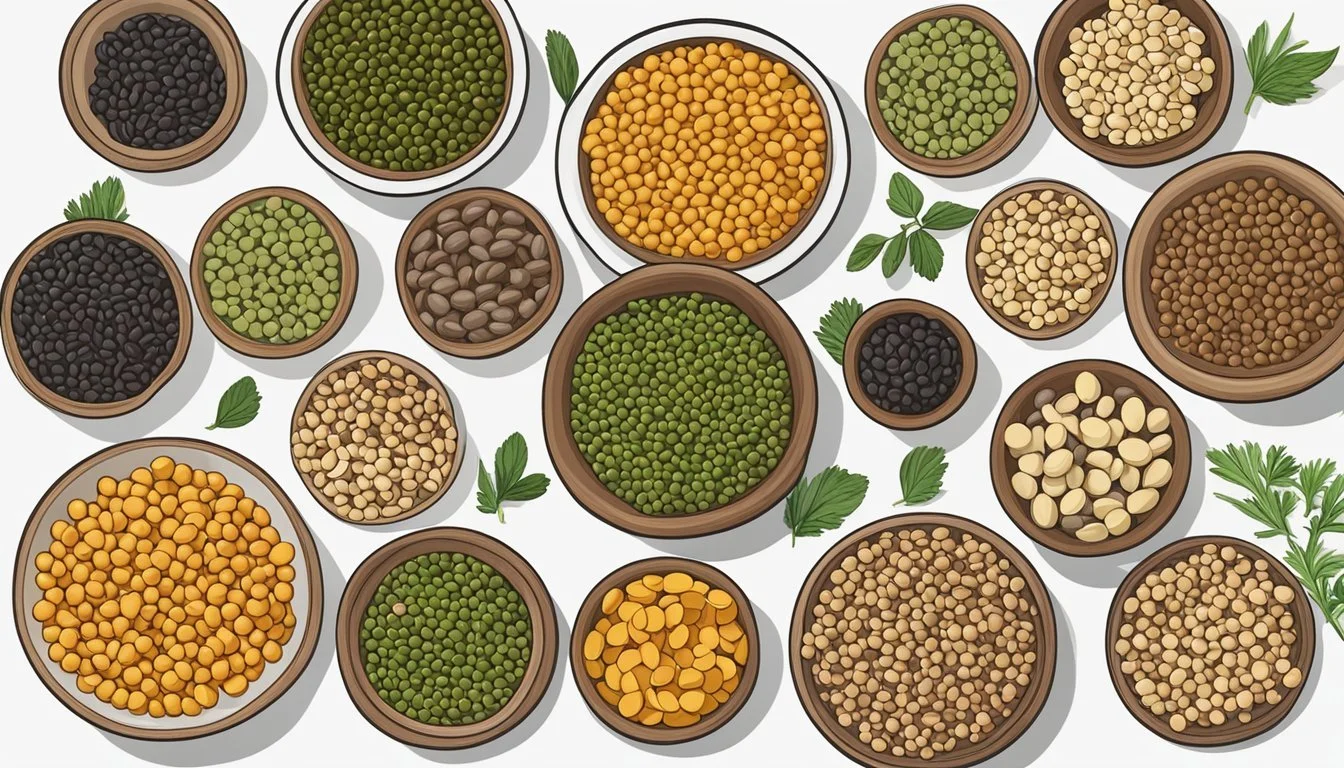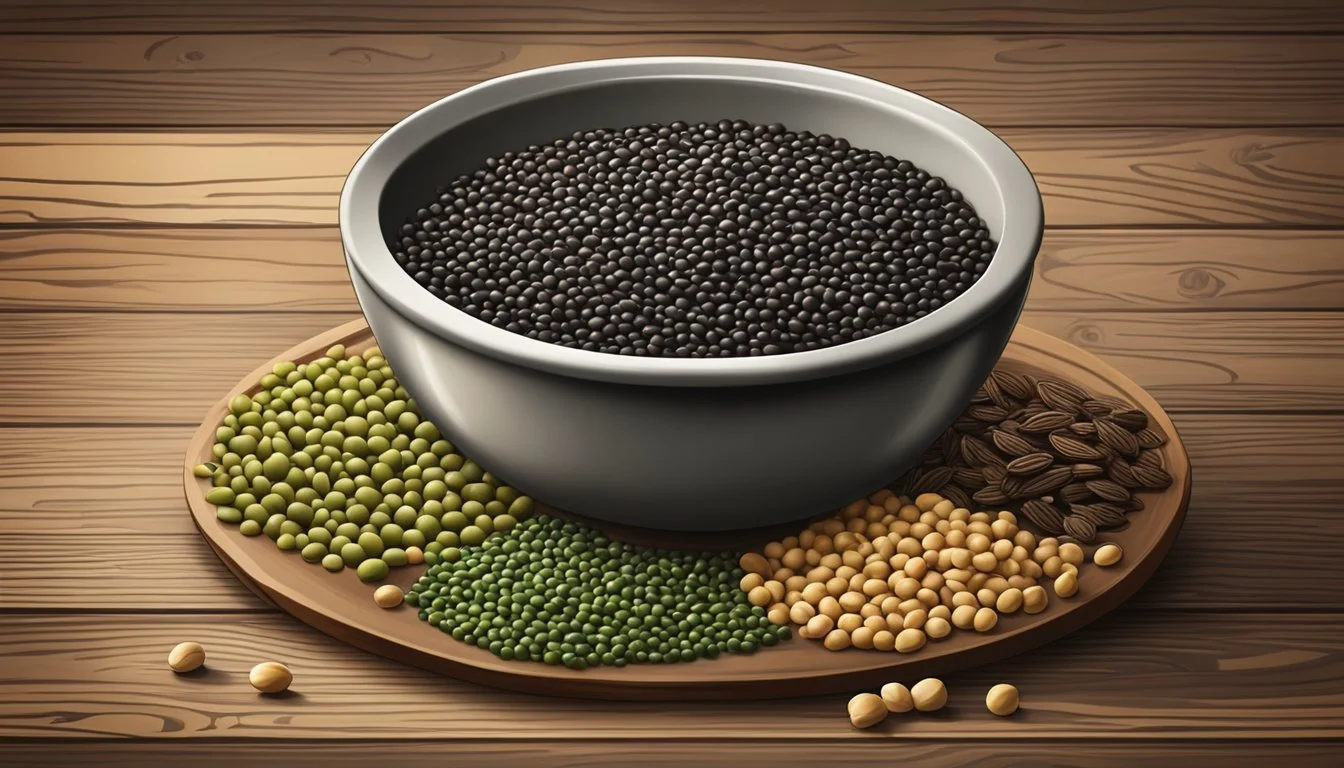Puy Lentils Substitutes
Top Alternatives for Flavor and Texture
Puy lentils, also known as Lentilles du Puy, are a beloved staple in many kitchens, prized for their ability to hold their shape and their rich, peppery flavor. These small, greenish-blue lentils originate from the Le Puy region in France and are cherished for their versatility in a variety of dishes. Packed with fiber and protein, they are not only delicious but also highly nutritious.
For those seeking alternatives to Puy lentils, there are several viable substitutes that can replicate their texture and enhance your culinary creations. Black beans, for example, can be used in place of Puy lentils, bringing a rich, earthy flavor, though they may darken the color of your dish. Split peas are another excellent option, offering a similar flavor profile and maintaining their shape well, making them suitable for soups and salads.
Other legumes such as chickpeas and soybeans can also work as replacements. Both are high in protein and fiber, ensuring your dishes remain nutritious and flavorful. These alternatives provide flexibility for those times when Puy lentils are unavailable, allowing you to continue making your favorite recipes without compromising on taste or nutritional value.
Understanding Puy Lentils
Puy lentils, also known as French green lentils, are renowned for their unique qualities. Originating from the Puy region in central France, they are often prized for their robust and earthy flavor.
Unlike other lentils, Puy lentils have a firm texture, which helps them maintain their shape during cooking. This makes them ideal for salads and side dishes.
Nutritionally, Puy lentils are rich in protein, fiber, iron, and folate. These nutrients make them a healthy addition to various meals, contributing to a balanced diet.
Nutrient Amount per 100g (cooked) Protein 9g Fiber 8g Iron 3.3mg Folate 181µg
Cooking time for Puy lentils is typically around 20-25 minutes. This is relatively short, making them convenient for quick meal preparations.
The resilience of Puy lentils' texture means they are often used in warm and cold dishes. Their ability to hold up in longer cooking processes also makes them suitable for soups and stews.
Best Substitute Options
When looking for substitutes for Puy lentils, consider the flavor profile, texture, and cooking time of the alternatives. Here are the top three lentil varieties that can effectively replace Puy lentils in a variety of dishes.
Green Lentils
Green lentils are one of the best alternatives to Puy lentils. They offer a similar earthy flavor and maintain their firm texture when cooked. They are ideal for soups, stews, and salads due to their ability to hold shape without becoming mushy.
Green lentils typically take around 30-45 minutes to cook, similar to Puy lentils. They are also versatile, making them a perfect substitute in side dishes and various main courses. Their earthy flavor and adaptability to a range of spices make them suitable for diverse culinary applications.
Brown Lentils
Brown lentils are another excellent option for replacing Puy lentils. These lentils have a milder flavor and a slightly softer texture. They are commonly used because of their shorter cooking time, usually between 20-30 minutes.
Brown lentils are versatile and adapt well to many recipes, making them suitable for soups, stews, and casseroles. They pair well with a variety of herbs and spices, and their mild taste allows them to absorb flavors from the dish effectively. Plus, their ability to hold shape makes them a solid choice for salads and side dishes.
Black Lentils
Black lentils, also known as Beluga lentils, offer a rich, earthy flavor and firm texture, similar to Puy lentils. They are small, round, and retain their shape well after cooking, making them ideal for soups, stews, and side dishes.
These lentils have a distinctive appearance, with a glossy, black coating that can add a visual appeal to your dishes. They cook in about 20-25 minutes, providing a quicker alternative while still delivering a robust texture. Black lentils are also rich in protein and fiber, enhancing the nutritional value of your meals.
By considering these alternatives, one can replicate the desired flavors and textures of Puy lentils in a variety of culinary applications.
Legume Substitutes
Legumes such as chickpeas, black beans, kidney beans, and soybeans provide plenty of nutritional benefits and can be excellent substitutes for Puy lentils in various recipes. These options are high in plant-based protein, fiber, and other essential nutrients, making them ideal for both vegetarian and vegan diets.
Chickpeas
Chickpeas, also known as garbanzo beans, are a versatile and nutritious alternative to Puy lentils. They have a slightly nutty taste and a creamy texture that holds well in cooked dishes.
Chickpeas are rich in protein and fiber, making them an excellent choice for salads, stews, and soups. They are also the main ingredient in hummus, providing a hearty and satisfying option for dips and spreads.
Nutritionally, chickpeas are packed with vitamins and minerals, including iron, magnesium, and folate.
Black Beans and Kidney Beans
Black beans and kidney beans both provide a robust flavor and are excellent for adding texture and nutrition to dishes. Black beans have a slightly sweet taste, which makes them a great addition to tacos and chili.
Kidney beans, with their firm texture, are perfect for hearty stews and soups. Both types of beans are high in protein, fiber, and essential nutrients, making them valuable substitutes for Puy lentils in vegetarian and vegan cuisine.
These beans can be found in a variety of dishes, from robust chili recipes to flavorful bean salads.
Soybeans and Soy-Based Substitutes
Soybeans and soy-based products such as tofu and tempeh are rich in protein and serve as excellent substitutes for Puy lentils. Tofu, a versatile soy product, absorbs flavors well and can be used in a wide range of dishes, including stir-fries and soups.
Tempeh, which has a firmer texture and a nutty flavor, is perfect for pan-frying and grilling. Both tofu and tempeh are gluten-free and are excellent meat substitutes, providing a high amount of protein and fiber.
These soy-based options are ideal for those following vegan and vegetarian diets, offering a nutritious and versatile alternative to Puy lentils.
Grain and Seed Alternatives
When looking for grain and seed alternatives to Puy lentils, options like quinoa and barley stand out. These substitutes offer similar textures and nutritional benefits, satisfying the needs of various dishes.
Quinoa
Quinoa is an excellent substitute for Puy lentils due to its high protein content and complete profile of essential amino acids. It has a slightly nutty flavor and a light, fluffy texture when cooked.
Quinoa cooks quickly, usually within 15 minutes, making it a time-efficient choice for busy kitchens. It's also rich in fiber, making it a filling option for salads, side dishes, and more. This grain is gluten-free and suitable for vegan and vegetarian diets.
Popular uses:
Salads: Adds texture and protein
Side dishes: Pairs well with vegetables and proteins
Main courses: Can be used as a base for bowls and grain-based dishes
Barley and Other Grains
Barley is a hearty grain with a chewy texture that works well as a Puy lentils substitute in soups and stews. It requires a longer cooking time of about 40-50 minutes but offers a rich, satisfying texture.
Barley is also high in fiber and contains significant amounts of vitamins and minerals. When using barley, it's best to cook it separately to ensure it reaches the desired tenderness.
Another grain option includes brown rice, which offers a mild flavor and slightly chewy texture. Kamut, an ancient grain, is also an excellent choice with a nutty flavor and robust texture, ideal for hearty dishes.
Popular uses:
Soups and stews: Adds bulk and fiber
Salads: Fits into grain-based salads
Side dishes: Complements a variety of proteins and vegetables
These grains are versatile and filling, making them suitable for many culinary applications.
Nut and Seed Substitutes
Nut and seed substitutes offer various textures, flavors, and nutritional profiles. These alternatives cater to those with allergies or dietary restrictions while providing similar dietary benefits like protein.
Peanuts and Tree Nuts
Peanuts and tree nuts can be used in place of lentils to add crunch and protein to dishes. Peanuts are legumes with a mild, slightly sweet flavor when roasted, and they maintain their crunchy texture. They are low in fat and serve as excellent protein sources.
Tree nuts like almonds, cashews, and walnuts offer a variety of textures and flavors. Almonds have a firm texture, cashews are creamy when cooked, and walnuts add a rich, earthy flavor. These nuts can be chopped or processed to mimic the shape and size of lentils, ensuring they integrate seamlessly into recipes.
Other Plant-Based Substitutes
For those seeking alternatives to Puy lentils, there are various beans and pureed forms that can be used. These substitutes offer similar nutritional profiles and versatility in various dishes.
Mung Beans and Other Beans
Mung beans serve as an excellent substitute due to their high protein and fiber content. These green legumes work well in soups, stews, and salads. Cannellini beans and navy beans also make great alternatives because they are easily available in both dried and canned forms.
Cannellini beans, with their creamy texture, are perfect for casseroles and dips. Navy beans, small and white, are ideal for soups and can be used to make veggie burgers. Pinto beans, known for their robust flavor, fit well in Mexican dishes and as fillings in burritos.
Lentil Substitutes in Pureed Form
Pureed forms of lentil substitutes are great for creating smooth textures in dishes. For instance, hummus, usually made from chickpeas, can replace lentil purees in spreads and dips. The creamy consistency pairs well with vegetables and breads.
Pureed cannellini beans provide a rich, buttery texture suitable for soups and pasta sauces. This substitution not only adds protein but also a smooth consistency. Using pureed beans also makes the dish vegetarian-friendly while enhancing its nutritional profile.
In addition, various beans can be cooked and blended to form a base for veggie burgers, making them a versatile option for meatless meals.
Considerations for Selecting Substitutes
When selecting substitutes for Puy lentils, several factors need to be considered to ensure the best match.
Nutritional Content:
Puy lentils are rich in fiber, proteins, vitamins, and minerals like potassium and manganese. Substitutes should ideally offer similar health benefits. Chickpeas and black beans are good choices as they provide comparable nutritional profiles.
Flavor Profile:
Puy lentils have a rich, peppery flavor. When choosing substitutes, it's important to select those with complementary flavors. Chickpeas provide a slightly nutty taste, while black beans offer a robust flavor. Both can blend well with a variety of spices and ingredients.
Cooking Times:
Puy lentils cook relatively quickly. Substitutes need to have similar cooking times to maintain recipe accuracy. Red lentils cook faster and can be a convenient option for busy cooks. Beans like chickpeas may need pre-soaking and longer cooking times.
1:1 Ratio:
For ease of substitution, it's beneficial to select options that can be replaced in a 1:1 ratio. This helps maintain the integrity of the dish. Lentils, like red or brown, often fit this requirement, though black beans can also work with some adjustments in cooking times.
Dietary Restrictions:
Some substitutes may cater to specific dietary needs. For example, individuals avoiding legumes due to allergies might consider grains like quinoa. Quinoa is high in protein and fiber, making it a nutritious alternative.
Considering these factors ensures that the chosen substitute aligns well with the intended culinary and nutritional outcomes.








